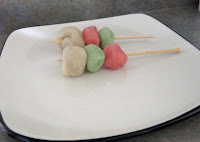 The Manga Cookbook by Manga University is a manga style cookbook full of interesting insights on Japanese history and culture, but most importantly it brings to life some of the foods that are frequently referenced in many of the manga I read. The illustrated instructions looked fun and easy to follow so the kids and I got inspired to try some.
The Manga Cookbook by Manga University is a manga style cookbook full of interesting insights on Japanese history and culture, but most importantly it brings to life some of the foods that are frequently referenced in many of the manga I read. The illustrated instructions looked fun and easy to follow so the kids and I got inspired to try some. First we needed to acquire the necessary ingredients. There is a nice section at the front of the book that outlines some of the key ingredients that may be harder to find in the west. As we happen to live near a newly opened Asian Supermarket, it gave us an excuse to go and check it out. We managed to find pretty much everything we needed. Only the rice flour was a little challenging as there was a lot of it to choose from and none of it had same name as the ones in the book so I went with what I hoped would be an equivalent.
 |
| My first Onigiri |
The first thing I made was steamed rice. I found the preparation to be the similar to making basmati rice (wash and soak before cooking). The water to rice ratio was different as was the type of rice, of course. With the steamed rice in hand, it was time to make Onigiri or Rice Ball. I’ve never seen one in real life so I wasn’t sure of the size, but I think they turned out alright. One thing I discovered is that I’m in need of a good sharp knife so that I can actually cut the nori rather than shred it. As for the nori (roasted seaweed) itself, I am still trying to get used to the taste. Where I live is probably as far from the ocean as you can get, it's not something I’m familiar with.
 |
| 3-Color Dango |
We are continuing to try the different recipes, as there are many more that we need to explore. I’m predicting that this year’s school lunches are going to be a lot more interesting.
Our family recommends this book; it’s a great way to try some simple new and tasty dishes and has proven to been a fun summer discovery.
The Manga Cookbook is presented by the Manga University Culinary Institute, recipes by Yoko Ishihara and illustrated by Chihiro Hattori, Published by Japanime Co. Ltd.
No comments:
Post a Comment